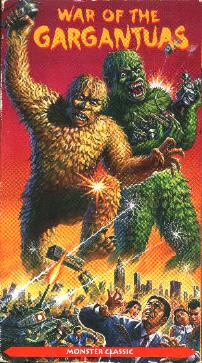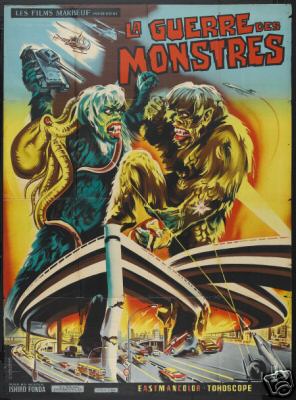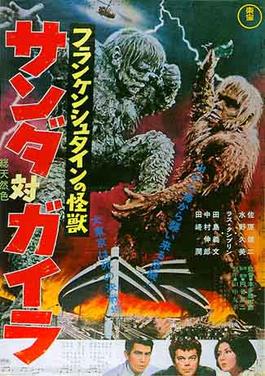You might know this movie by its original Japanese title Furankenshutain no Kaijū: Sanda tai Gaira but you probably don't. The plot has a simple beauty: there are two monsters who appear suddenly and mysteriously called Gargantuas that kinda look like 200 foot tall Sasquatchs. The English dialogue calls them 'The Brown One' and 'The Green One' which is uncreative but accurate as far as their fur is concerned. The Green One is better known as Gaira, named for his habitat of choice, the sea; The Brown One is Sanda, named for his home, the mountains. What divides these colossal brothers and leads to their titular confrontation is their stances on killing people and smashing vehicles/buildings. The Green One is strictly in favor of both those things, whilst The Brown One fondly recalls growing up in a laboratory amongst human scientists and subsequently is not too fond of eating them or smashing their vehicles/buildings. Unfortunately for Japan, and very fortunately for the viewers, the only way for them to settle their differences is with a crowd-pleasing metropolis-leveling no-holds-barred death match; make some gigantic popcorn.
The gigantic gruesome twosome are compelling characters with some oddly touching scenes, even though they are obviously just stuntmen in big funny costumes smashing toy cars and 3ft tall buildings. They don't speak, and yet you can understand their disagreements. The Brown One comes across The Green One lounging against a mountain, with his feet in the air and his hands behind his head, with a pile of human detritus next to him. You see Brownie's eyes darting around connecting the dots, and you hear his emotional grunts progress from confusion to rage. After Brownie puts 2 and 2 together, he rips an enormous tree from the cliff side and brains Greenie with it before he knows what's happening.
Maybe if Japan was allowed to have a real military they would be better at fighting giant monsters, but the peacekeeping force or the anti-Gargantua force or whatever they call themselves (lets call em the good guys) the good guys certainly try lots of dubious sounding methods to fend off the people-hungry Green One. They try staring and screaming until they're eaten but that doesn't work, so then they try flying helicopters near his head one at a time until he remembers that he can jump and swat, but that doesn't work either, so they actually try shooting at him with guns and tanks, and it works enough to upset him, so he picks up the tanks and throws them into buildings. Hmmmm..... Maybe we're not looking at this the right way.
Savvy Japanese producers liked to incorporate at least one American as a reporter or a scientist in their monster movies so xenophobic viewers would sit still long enough to realize that 'smash' and 'boom' are universal languages. The Yank in the picture here is Russ Tamblyn, still riding the high of his part as Riff in 1960's West Side Story, playing the scientist who originally created the Brown One from the cells of some other dead monster's severed hand from a different movie; the origin of the Green One is allegedly some of those same cells sneaking out of the lab and into the ocean where they ate lots of plankton.
Instead of being furious at Riff for practicing reckless unlicensed monsterology, the good guys consult with him to develop a weird solar-laser-lightning cannon or something that exclusively harms the Green One. Well Riff's weapon ends up working about as well as his English. Wait a minute. Russ Tamblyn speaks English. Why is he dubbing himself? And poorly. They changed around some of the story during the four years it took the film to reach the USA from Japan. The word 'Gargantua' comes up roughly 175 times in this movie, and Riff's lips never look like that's what he's saying; that's because he was saying something else entirely, but we'll get back to that.
Speaking of dubbing, yes, everybody else in the film is dubbed. Here's the magic formula for dubbing films: you add up all the male parts in the film, then you add up all the female parts in the film, and then you just get two guys and one lady to do everything. The men have to really stretch, incorporating unlikely regional accents and guessing the ages of the characters they're voicing in the film they haven't seen. But the one woman usually voices all the lady parts (heh) and any child roles too, so they are really the unsung heroes of an unappreciated world; if it wasn't for them, you'd have to read. Read? I can't read now, I'm watching a monster pick up an oil tanker and crack it over his knee!
~ When the good guys are brainstorming monster repellent strategies, somebody suggests using napalm to burn all the oxygen around the monsters and suffocate them. Holy shit, is that safe? That doesn't sound safe. People might need that oxygen.
~ Any chance this movie has an insane backstory that was cut from the American release? Yup. The hand that provided the cells that produced the title beasts was actually the hand of Frankenstein's Monster. Beg Pardon? In a previous movie called Frankenstein Vs. Baragon (or Frankenstein Conquers The World in the Frankenstein-loving US of A) the Japanese Army has the German Army pass them the "immortal heart" of Frankenstein's Monster during WWII but before they could experiment on it, the Americans dropped the Bomb and gave the magic organ a healthy dose of radiation which, in twenty years time, grew the monster back to life and up to super-sized big-monster-brawling proportions, at which point he lost one of his hands.
~ Wait, seriously? The Gargantuas are the mutated offspring from the severed hand of a 200 year old nuclear powered Frankenstein's Monster? So Riff was saying Frankenstein instead of Gargantua and then they dubbed over it? No wonder his lips didn't match.
~ Any clues to this unsaid wackiness? If you look at the word "Furankenshutain" in the original title and squint hard enough, I think you can figure it out.
~ Why Frankenstein's Monster? The original 1818 novel has long been public domain, but the iconic design everyone automatically associates with the monster was created by makeup legend Jack Pierce, with no relation to anything described in the novel. Universal Studios made umpteen sequels to the original Frankenstein from 1931 before the franchise eventually petered out with 1948's Abbot and Costello Meet Frankenstein. But in 1957 Hammer Studios in England started their own series of Frankenstein movies, which had even less to do with the book than the Universal series of films did, and had nothing to do with the Universal films for fear of legal action. Audiences experiencing withdrawals after almost a decade without any new Frankenstein movies packed the theaters, and so the Hammer series was also successful and long-running, paving the way for any other film studios to use the Frankenstein characters (Doctor and/or Monster) so long as they stayed away from the classic flattop, green-skin and neck-bolts combination we're all so familiar with. By the time the last Hammer film came out in 1974, Frankenstein's Monster had been a box-office draw for over four decades, and he wasn't going anywhere; 1974 also saw the release of Young Frankenstein which went on to earn over 86 million dollars and in 2003 was placed alongside the film it was parodying in The Library of Congress National Film Registry.
~ "I was gonna make espresso!"




Last sentence of paragraph 5 "because he was saying something entirely" should be "saying something else entirely" or "saying something entirely different."
ReplyDeleteparagraph 1, comma after but
ReplyDeleteparagraph 1, very fortunately for the viewers, change fortunately to fortunate
ReplyDeletepara 6, "everybody else is the film is dubbed" change "is the" to "in the"
ReplyDelete"paragraph 1, comma after but"
ReplyDeleteThis doesn't make sense; I suspect you are a weeger.